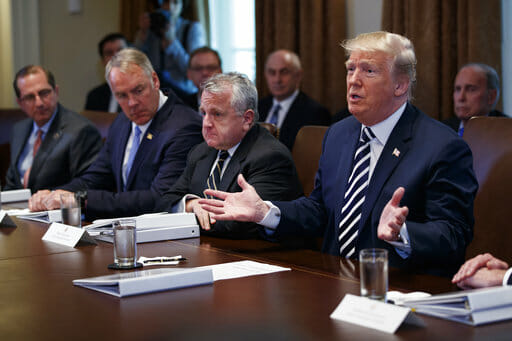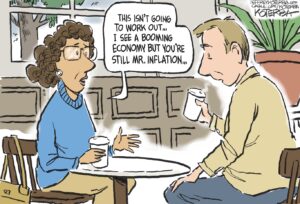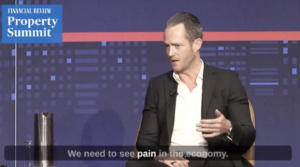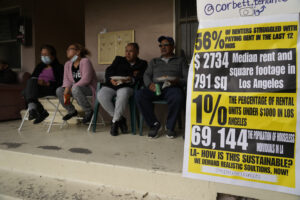Despite the Hype, U.S. Is Not at Full Employment
Meanwhile, Trump administration policies going into effect based on incomplete unemployment data do nothing but harm. President Donald Trump at a Cabinet meeting this month. (Evan Vucci / AP)
President Donald Trump at a Cabinet meeting this month. (Evan Vucci / AP)
There is a general consensus that the U.S. economy is close to full employment, given that one of the most commonly used measures (based on nonfarm payroll data from the Bureau of Labor Statistics) indicates an unemployment rate that has fallen to 3.9 percent. As good as that figure appears to be, it is troubling that wage growth for the majority of Americans remains tepid, hardly what an observer would expect if the labor markets were as tight as implied by that number. And in fact, if one digs into the data a bit more closely, it does bring to mind the old expression commonly attributed to Mark Twain about “lies, damned lies, and statistics.”
The problem with these employment statistics (or “damned lies,” depending on one’s perspective) is that they could well be overstating the current strength of the U.S. economy, which is problematic given that U.S. consumers are already seeing their discretionary income squeezed by interest rate hikes (higher credit card servicing, more expensive mortgages) and higher energy prices. Additionally, while many economists champion our “flexible, gig economy,” the reality is that for many workers this “flexibility” represents in fact “casualized” labor, that is to say, involuntary part-time work, which is unaccompanied by benefits such as health care. This puts more strains on the economy and exacerbates worker insecurity (hardly propitious in terms of encouraging consumer confidence). And the economy as a whole is still characterized by a large stock of private debt, much of which hasn’t been resolved or restructured (as was the case, for example, during the Great Depression). Therefore, if policymakers continue to lean into this tepid recovery via more interest rate hikes and/or tighter fiscal policy, they could well tip us back into recession (or something worse).
A longstanding problem relating to our economic measurements such as employment is that U.S. policymakers see much of the employment data at the same time that the public does, and they are forced to make decisions based on these estimates. The bottom line is that what most people want to get out of unemployment data is not only what the current number is and if it’s getting better or worse recently, but also what it means for policy. Will interest rates continue to be raised? Will there be more cuts in government spending? As far as the policy response to the current employment situation, policy is largely based on the less comprehensive measures calculated (based on volatile monthly employment data), reported (sent out to the public and policymakers alike at the same time, even though it’s often subject to significant revision later)—meaning that, in spite of the bests efforts of the people working at the Bureau of Labor Statistics (BLS), our monetary and fiscal officials are a bit like the proverbial pilot flying without a full complement of engines or navigational equipment.
To dig into the weeds a bit further, the payroll and household surveys are two different samples designed to track the more comprehensive Business Enterprise Dynamics (BED), but which are published earlier than the BED. The payroll is structured around a sample of companies, and the household around a telephone sample of households where employees live. The payroll survey covers a much larger number, but, once set up, suffers from the weakness that it reflects company failures that drop out of the sample, while only guessing at new companies starting up (the so-called “birth-death model” tries to cope with this). The household model is small and very variable month to month (there is no penalty for not answering). Basically, policymakers must use a compendium of measures to get the best picture of what is happening. But the third and most comprehensive measure, the BED, takes several months to compile accurately, which means that policymakers are seldom getting a full picture, which is particularly important if and when the economy hits an important inflection point.
Based on recent publication of the BED data (which currently is only compiled to the third quarter of 2017), there are hints that employment is not as robust as the payroll and household survey measures have hitherto suggested. This disparity might also help to explain why wage growth remains so tepid, in spite of the repeated characterization that we are close to full employment. And the worst thing from a political standpoint is that the Trump administration has essentially discredited the use of additional fiscal policy by directing so much of his tax cuts to wealthy individuals and corporations, who are more likely to save the money than to reinvest it in the economy, rather than direct them to middle and working classes, who need it most and would do the economy best if they had those resources because they would be more likely to spend the tax dollars. Higher consumption would (as economists like to say) increase the multiplier effect on the economy as a whole. Most worrisome is that because of the Trump policy error, he may well have politically discredited the use of fiscal policy as a lever to combat recession. One can easily imagine that the next time anybody suggests more fiscal stimulus, the deficit scolds are almost certain to argue that this was tried before (by Trump) and proved wanting, and besides, “we can’t afford it,” which is nonsensical.
And of course, the other point to bear in mind is that some 10 years after the great financial crisis of 2008, we still have lower employment participation rates, which is to say we have fewer people who are either employed or are actively looking for work in the economy as a whole (in part because they have become discouraged about their employment prospects), and a higher “casualization” of labor (i.e., the so-called “involuntary part-time” group, who generally work without the security of a long-term contract, and corresponding benefits such as health care). A recent study by the San Francisco Federal Reserve (written before the April employment data became available, but still relevant) highlights that:
“[I]nvoluntary part-time work was running nearly a percentage point higher than its level the last time the unemployment rate was 4.1%, in August 2000. This represents about 1.4 million additional individuals who are stuck in part-time jobs. These numbers imply that the level of IPT work is about 40% higher than would normally be expected at this point in the economic expansion.”
This goes a long way toward explaining why wage pressures remain strikingly subdued, indeed, the most convincing empirical evidence suggesting that the labor market in the U.S. is not nearly as robust as the payroll figures imply.
So the BED report may have much broader ramifications for us, especially as the Federal Reserve continues to raise interest rates and calls mount from congressional deficit hawks, such as House Speaker Paul Ryan, to adopt a “more responsible” fiscal posture (for “fiscally responsible,” read: “austerity”). These warnings are based on the same view that the economy is rapidly growing to full capacity and is likely to encounter inflationary bottlenecks.
But this certainly isn’t being borne out by wage growth, which, even though increasing at 2.3 percent year over year, continues to be relatively subdued by historic standards. By way of contrast, the last time the economy experienced an unemployment rate around 4 percent, wages were growing in the range of 3.5-4.0 percent. The SF Fed report suggests that were all the part-timers able to obtain gainful full-time employment, which they estimate to be around 1.4 million people, wage pressures would be significantly higher. But the authors go on to suggest that this involuntary part-time employment is here to stay, which would imply the need for a less hawkish monetary and fiscal policy stance, given that these part-timers in effect create an “army of partially employed,” which can be used by employers to deter aggressive demands for higher wages (using the threat of turning a full-time worker to a part-time “consultant” as a disincentive to strike for better pay). Buttressing the SF Fed study is a research report done by The Liscio Report’s Philippa Dunne (“May 3, 2018, Participation rates, wages, and market power”; TLR on the Economy, full text available with paid subscription) where the author makes clear that “a 1-point rise in the participation rate adds about 0.4 point to the growth in average hourly earnings (AHE).” This is a technical way of measuring how much higher wage growth would be if those with part-time jobs were able to secure full-time employment.
History shows that on its own, the nonfarm payroll report is a lousy statistic. Given the size of today’s labor force, the revisions to the originally reported number, which comes as more information becomes available to the BLS, can be in the hundreds of thousands. This is because the figures are based on extrapolations from a relatively small series, and they therefore tend to miss key inflection points, where the economy might suddenly stall if a major financial shock is encountered (such as was the case in 2008). Therefore, no matter what the underlying economic reality is, policymakers and the markets can get a payroll number in any month or even set of months that is very misleading. We experienced this phenomenon in the summer of 2008, when the payroll and household data was not yet recording the significant deterioration already being experienced in the economy (and which only became apparent when the BED revisions came in almost a year later). As Professor Bill Mitchell notes:
“What is apparent is that there is still no coherent positive and reinforcing trend in employment growth in the US labour market since the recovery began back in 2009. There are still many months where employment growth, while positive, remains relatively weak when compared to the average labour force growth prior to the crisis or is negative.”
Which also explains why wage growth has been so tepid. As economist Paul Krugman has noted in an op-ed for the New York Times: “if you want to boost overall spending, you don’t have to give huge tax breaks to corporations. You could do lots of other things instead—say, spend money on fixing America’s crumbling infrastructure, an issue on which Trump keeps promising a plan but never delivers.” In other words, Trump’s tax bill did not give the economy maximum bang for the buck. So if and when it becomes evident that the economy isn’t as strong as people think, the argument will be that we can’t do additional government spending or tax cuts, as that was tried under Trump without success. Parenthetically, that may have been the plan all along from some of the more Machiavellian members of the GOP, but hardly excuses the Democrats for their incessant focus on the deficit (see here, and here) rather than offering alternative fiscal policies that would generate more robust employment and income growth.
But this certainly isn’t being borne out by wage growth, which, even though increasing at 2.3 percent year over year, continues to be relatively subdued by historic standards. By way of contrast, the last time the economy experienced an unemployment rate around 4 percent, wages were growing in the range of 3.5-4.0 percent. The SF Fed report suggests that were all the part-timers able to obtain gainful full-time employment, which they estimate to be around 1.4 million people, wage pressures would be significantly higher. But the authors go on to suggest that this involuntary part-time employment is here to stay, which would imply the need for a less hawkish monetary and fiscal policy stance, given that these part-timers in effect create an “army of partially employed,” which can be used by employers to deter aggressive demands for higher wages (using the threat of turning a full-time worker to a part-time “consultant” as a disincentive to strike for better pay). Buttressing the SF Fed study is a research report done by The Liscio Report’s Philippa Dunne (“May 3, 2018, Participation rates, wages, and market power”; TLR on the Economy, full text available with paid subscription) where the author makes clear that “a 1-point rise in the participation rate adds about 0.4 point to the growth in average hourly earnings (AHE).” This is a technical way of measuring how much higher wage growth would be if those with part-time jobs were able to secure full-time employment.
History shows that on its own, the nonfarm payroll report is a lousy statistic. Given the size of today’s labor force, the revisions to the originally reported number, which comes as more information becomes available to the BLS, can be in the hundreds of thousands. This is because the figures are based on extrapolations from a relatively small series, and they therefore tend to miss key inflection points, where the economy might suddenly stall if a major financial shock is encountered (such as was the case in 2008). Therefore, no matter what the underlying economic reality is, policymakers and the markets can get a payroll number in any month or even set of months that is very misleading. We experienced this phenomenon in the summer of 2008, when the payroll and household data was not yet recording the significant deterioration already being experienced in the economy (and which only became apparent when the BED revisions came in almost a year later). As Professor Bill Mitchell notes:
“What is apparent is that there is still no coherent positive and reinforcing trend in employment growth in the US labour market since the recovery began back in 2009. There are still many months where employment growth, while positive, remains relatively weak when compared to the average labour force growth prior to the crisis or is negative.”
Which also explains why wage growth has been so tepid. As economist Paul Krugman has noted in an op-ed for the New York Times: “if you want to boost overall spending, you don’t have to give huge tax breaks to corporations. You could do lots of other things instead—say, spend money on fixing America’s crumbling infrastructure, an issue on which Trump keeps promising a plan but never delivers.” In other words, Trump’s tax bill did not give the economy maximum bang for the buck. So if and when it becomes evident that the economy isn’t as strong as people think, the argument will be that we can’t do additional government spending or tax cuts, as that was tried under Trump without success. Parenthetically, that may have been the plan all along from some of the more Machiavellian members of the GOP, but hardly excuses the Democrats for their incessant focus on the deficit (see here, and here) rather than offering alternative fiscal policies that would generate more robust employment and income growth.
Your support matters…Independent journalism is under threat and overshadowed by heavily funded mainstream media.
You can help level the playing field. Become a member.
Your tax-deductible contribution keeps us digging beneath the headlines to give you thought-provoking, investigative reporting and analysis that unearths what's really happening- without compromise.
Give today to support our courageous, independent journalists.









You need to be a supporter to comment.
There are currently no responses to this article.
Be the first to respond.